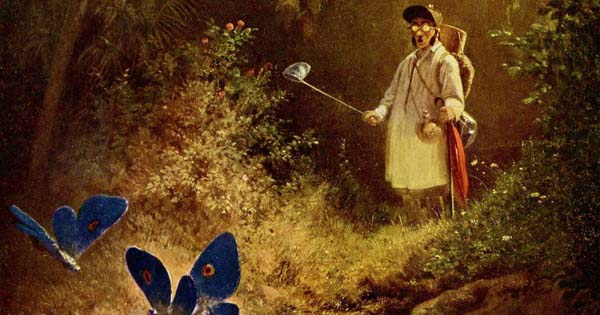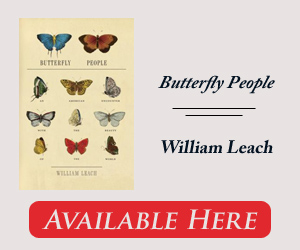
Butterfly People: An American Encounter with the Beauty of the World, By William Leach, Pantheon, 416 pp., $32.50
In the last decades of the 19th century, America produced a cohort of butterfly collectors, bound by a passion to possess and study the most beautiful things in the world. In Butterfly People, William Leach argues that these fanatics were heroes, whose writings and collections caused other Americans to pay close attention to the country’s “flying jewels,” as New York Entomological Society co-founder Augustus Grote called them. Natural history became more inclusive, the study of butterflies no longer just for lepidopterists with advanced degrees.
The beauty and variety of butterflies and moths seduced many of these men away from religion, in particular the belief that God created Earth and all its wonders. At a time when Harvard zoologist Louis Agassiz, probably the most famous scientist of the time, taught that new species arose at the direction of a divine creator, the butterfly collectors gradually came to believe, from direct observation, in Darwin’s theory of natural selection. Many of Leach’s butterfly men behaved like biologists—collecting eggs, raising caterpillars, closely examining butterfly anatomy. In fact, very close examination led to a major fight about whether one could distinguish species by the size and shape of butterfly genitalia.
The members of this band began as amateurs, freely sharing their observations and specimens. Their obsession coincided with a time that was a golden era for butterflies. Family farms made great habitat—unmown wildflowers, leafy woodland edges for the caterpillars, and plenty of manure, a source of minerals. Vladimir Nabokov, himself an amateur lepidopterist born at the tail end of the 19th century, once said he first understood irony when he saw butterflies clustered on a piece of dung.
Nabokov wrote that he came closest to ecstasy not when finishing a novel but when observing rare butterflies. Leach’s heroes experience the same rapture—one described himself as chasing after the creatures with the enthusiasm of a “crazed monk.” Leach himself was a 20th-century novice in the religion. At age nine, he became a butterfly collector: “Nothing else so fulfilling or exhilarating marked my childhood.” (At that age, I too was an embarrassment and inconvenience to my family, net in hand on every vacation, demanding we stop at any promising meadow or bog.)
From the many worthy 19th-century collectors, Leach selects one as the most accomplished. William Henry Edwards was a coalmine manager who created a streamside butterfly paradise with food plants for caterpillars and nectar-rich flowers for the adults. Its close proximity to the mine was an irony apparently lost on his contemporaries. A lifelong chronicler of butterflies, Edwards was in his mid-70s when he delivered the third and final volume of The Butterflies of North America.
Another who amassed an enormous collection and profound knowledge of the creatures while making a living at a hard job was Herman Strecker, a stonecutter who specialized in gravestones for children. As Edwards, Strecker, and others began comparing collections and theories, they became intensely competitive. Insulting letters flew back and forth; specimens were no longer freely shared. Strecker was even accused of stealing from a natural history museum.
The innocence of the early amateur years disappeared when butterflies became valuable consumer goods in a world market. As the richest Europeans and Americans began to accumulate ever-larger butterfly collections, hungering after the rarest specimens, some of the amateurs turned professional. They captured morphos, birdwings, or heliconians for rich men who never set foot near a jungle.
In writing about this diverse collection of collectors, Leach runs into problems, especially because he argues that all of them deserve to be better known. He first focuses on five, but then brings up ever more deserving enthusiasts, briefly sketched. The reader is left wishing he had limited his cast of characters to one or two heroes.
As for villains, Leach is more selective. He gives us William Holland, a Pittsburgh minister who “saw butterfly collecting—as he did everything else—as a route to high social rank.” His social climbing led to a profitable association with Andrew Carnegie, and he amassed his huge collection by outspending everybody else in America. Holland’s victim is William Doherty, a mentally fragile young man who decided to become a commercial dealer rather than a naturalist because he had a family to support and saw, he said, “dollar bills waving their green wings.” Holland, the man with the dollars, dispatched Doherty to Africa and Asia. As an employer he was slow to pay but quick to criticize, and without understanding the distances or dangers, he thought nothing of sending Doherty across hundreds of miles—from Kilimanjaro to Madagascar, for example—to acquire a specimen. After bouts of dysentery and typhoid, Doherty died in Kenya at age 44.
The rarest butterflies still attract speculators and smugglers, but both the innocence of collecting and the mania have largely faded. Leach’s 19th-century collectors would be shocked to see how butterfly habitats have been chopped up and paved over, and how so many different kinds of butterflies and moths have been greatly reduced in number. There are fewer family farms, fewer untouched acres, and fewer nine-year-olds venturing out with butterfly nets.
As the 19th century wound down, Leach’s original cast of butterfly collectors finished writing their guides, as Edwards did with his hefty three volumes; turned professional like the ill-fated Doherty; or simply grew old and sad that their strenuous collecting days were over. The amateurs were replaced by academic entomologists, many of them rewarded for finding better ways of killing caterpillars seen as agricultural pests.
Still, butterflies keep some of their mysteries. The biggest one is metamorphosis. Much that occurs inside the chrysalis is known, but what in the name of God, or Darwin, triggers the cascade of changes that turns a caterpillar into a butterfly? The answer still escapes entomologists and developmental biologists. The elusive quality of the butterfly, wild and on the wing, makes it a perfect object of desire. When one alights, we stand as still as we can and observe with awe. But reach for it, and it floats away.


